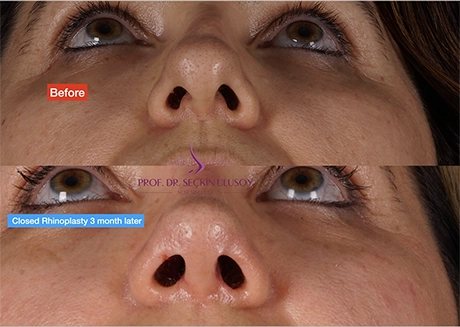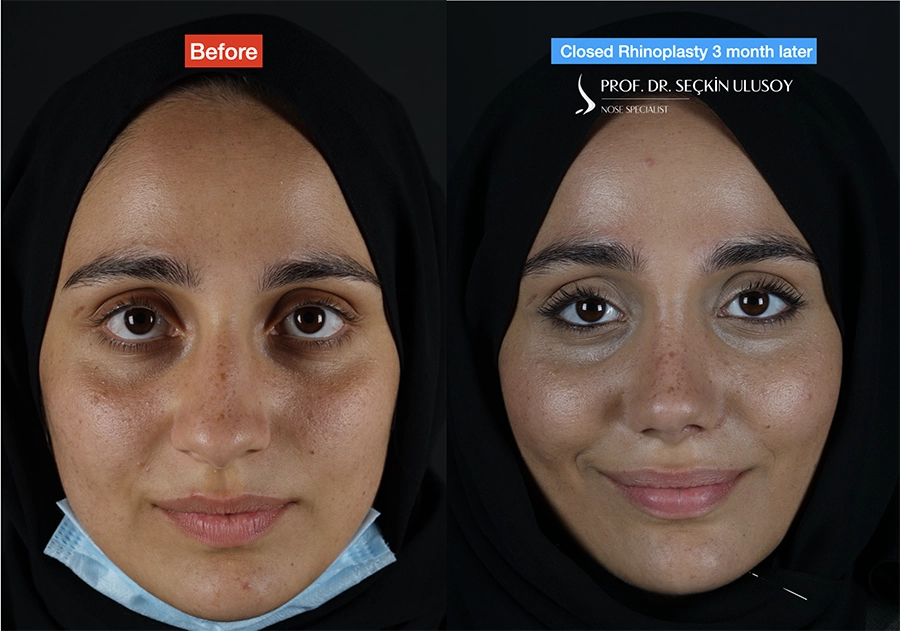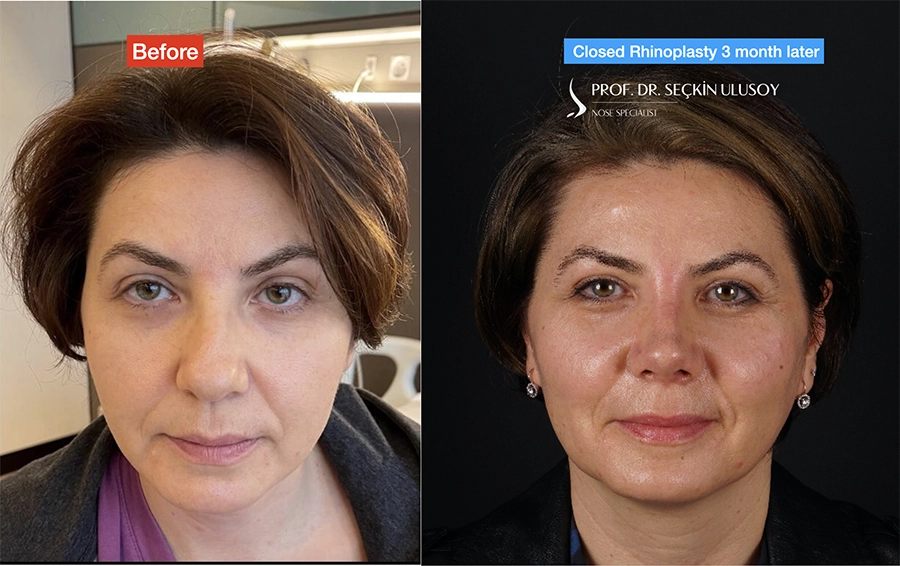Closed Preservation Rhinoplasty: Aesthetic and Functional Nose Surgery
Closed preservation rhinoplasty is a surgical procedure used to reshape and modify the structure of the nose through incisions only inside the nose. Unlike traditional rhinoplasty, this technique does not involve making any skin incisions or cutting the lower part of the skin’s soft tissues from the nasal framework. Closed preservation rhinoplasty has been gaining popularity among surgeons and patients due to its less invasive nature and quicker recovery time. In this article, we will discuss the details of this technique, its benefits and drawbacks, the recovery process, and the types of patients suitable for this procedure.
Introduction to Closed Preservation Rhinoplasty
Rhinoplasty, commonly known as a nose job, is a surgical technique to reshaping of the dorsal hump with preserving natural nose bone and cartilage. Closed preservation rhinoplasty is a minimally invasive technique that has gained popularity recently due to its numerous benefits over traditional structural rhinoplasty. This article will explore closed preservation rhinoplasty and its pros and cons.
What is Closed Preservation Rhinoplasty?
Closed preservation rhinoplasty is a surgical procedure that reshapes the nose while preserving the nasal structures. Unlike traditional open rhinoplasty, where incisions are made on the outside of the nose skin, closed preservation rhinoplasty involves making internal incisions, leaving no scars. This technique is beneficial for patients who want to improve the appearance of their nose without undergoing extensive surgery and for more natural results.
History of Closed Preservation Rhinoplasty
Closed preservation rhinoplasty was first introduced in the 1950s. So, the history of protective nose job surgeries is quite old. However, due to the lack of advancements in endoscopy and video communication at that time, it couldn’t become widespread worldwide. It was only performed by a few surgeons knowledgeable about the technique. However, after the 1990s, with the introduction of endoscopes in medicine and the increased communication through the internet era, many surgeons were able to learn and apply this method. As a result, it has become trendy in the last decade.
Benefits of Preservation Rhinoplasty over Traditional Structural Technique
Less Invasive Procedure
Closed preservation rhinoplasty is a less invasive surgical technique than the traditional open structural procedure. The incisions used in this technique are made internally, without skin scars. Furthermore, the original nose ridge, including many parts, remains preserved since the natural bridge is lowered without being cut. This means less trauma to the nose, leading to less bleeding and swelling.
Faster Recovery Time
The recovery time for closed-preservation rhinoplasty is shorter than that for traditional rhinoplasty. Since the procedure is less invasive, patients experience less swelling, bruising, and pain and can return to their daily activities much sooner.
Minimal Swelling and Bruising
Closed preservation rhinoplasty is known for causing minimal swelling and bruising. This is because the procedure does not involve extensive dissection of the nasal tissues. Patients can expect to have a quicker and less uncomfortable healing period.
Patients can change the shape of their nose as desired through massage.
In open surgery, the nasal bridge is cut, grafts are placed to repair it, while the sides of the nose are released and the open roof is closed. Massage application is beneficial for reducing swelling. However, in preservation rhinoplasty, since the natural nasal bridge is preserved and the entire nose is mobilized from the sides and nasal radix, massages according to the patient’s wishes after the surgery are also highly effective in settling the nose shape. Furthermore, the nasal tip is much more flexible and mobile in closed-preservation rhinoplasty. In this method, the patient also has the opportunity to increase or decrease the nasal tip through massages.
Natural Looking Results
Since closed preservation rhinoplasty preserves the nasal structures, the results look more natural than traditional rhinoplasty. The natural contours of the nose are preserved with little reshapings, resulting in a more aesthetically pleasing appearance.
The Procedure of Closed Preservation Rhinoplasty
Anesthesia and Incisions
Closed preservation rhinoplasty is performed under general anaesthesia. The surgeon makes 180-degree internal incisions in the entrance of the nasal cavity; this incision scar is not visible from the outside. Therefore, the surgeon reaches all the nasal skeleton details via a headlight or endoscope. This eliminates the need to make any external incisions.
Techniques Used in Closed Preservation Rhinoplasty
The surgeon uses various techniques to reshape the nose during closed preservation rhinoplasty. These techniques include altering the shape and size of the nasal bones, reshaping the nasal tip, and correcting the asymmetry of the nose. To reduce the height of the nose with this method, the nose is lowered downwards by using some natural structures with the septum cartilage removal method. Therefore, it is aimed at obtaining a natural ridge. In addition, in this method, many soft tissues, nasal muscles, and ligaments are preserved together with subcutaneous blood vessels and lymphatic structures in all anatomical regions of the nose.
Sculpting and Reshaping the Nose
The surgeon performs the necessary sculpting and reshaping of the nose with power instruments ( Ultrasonic or Piezo Devices ) through the internal incisions. The nasal tissues are manipulated to achieve the desired results. Once the reshaping is complete, the incisions are closed using dissolvable stitches.
Recovery with Preservation Rhinoplasty
Immediate Post-Operative Care
After the procedure, the patient’s nose is packed with special dressings (Tapes, Casts, inside nose silicones ) to reduce the risk of bleeding and aid in the healing process. Patients are typically monitored in a recovery area for a few minutes and stay one night in the hospital before going home or to a hotel.
Recovery Timeline and Restrictions
Patients can expect to take one to two weeks off from work or school. During this time, they should avoid vigorous activity, bending over, and lifting heavy objects. Patients should also sleep with their heads on elevated pillows for the first few weeks to reduce the swelling.
Follow-up Appointments and Care
Patients are typically required to see their surgeon for follow-up appointments to ensure proper healing and monitor the progress of the nose. The surgeon will provide instructions on caring for the nose during the healing process, such as cleaning the incisions and avoiding contact sports. Patients can expect excellent results from their closed preservation rhinoplasty procedure with proper post-operative care and correct massages.
Candidates for Closed Preservation Rhinoplasty
Are you considering having a closed preservation rhinoplasty? Here are three characteristics that make you a good candidate:
Healthy Individuals:
Individuals who are physically and mentally healthy can tolerate the surgery’s stress and undergo anaesthesia. Certain medical conditions can increase the risk of complications, so ensure that your rhinoplasty surgeon knows your medical history.
Individuals have Functional or Cosmetic Nasal Issues:
Closed preservation rhinoplasty is ideal for individuals who want to improve their nose’s appearance and functionality. If your nose is asymmetrical, blocked, or oversized, closed preservation rhinoplasty can help alleviate many of these problems. Crooked noses are the best indications of preservation rhinoplasty surgery because the surgeon can mobilise the whole bony pyramid with an ultrasonic power instrument during this procedure.
Realistic Expectations for Results:
It is crucial to have realistic expectations when undergoing closed preservation rhinoplasty. While this surgery can help improve your nose’s appearance and function, it cannot make you look different. Therefore, it’s essential to have an honest conversation with your rhinoplasty surgeon to achieve the best results.
How should I manage my expectations after the closed preservation rhinoplasty surgery?
Even though this surgery can significantly improve the shape of your nose, achieving perfection depends on factors such as your age, skin, cartilage, bone structure, and facial anatomy. Therefore, any plastic surgeon can guarantee they will give you the best nose in the world. What matters in this surgery is the proportion of positive changes, which may rarely reach 100%. Your psychology needs to be prepared for this and realistically for the results.
Closed rhinoplasty is becoming increasingly popular with current medical technologies. Here are some of the most significant pros and cons of closed preservation rhinoplasty:
Advantages of Closed Preservation Rhinoplasty:
- Shorter recovery time
- Less swelling and bruising compared to open rhinoplasty
- Reduced risk of scarring
- The procedure is less invasive compared to open rhinoplasty
- The patient can change their nose shape with massage depending on their wishes
Disadvantages of Closed Preservation Rhinoplasty:
- Less visibility for the surgeon and needs surgeons with more experience for better nostril symmetry
- Limited surgical access compared to open rhinoplasty
- Complex revisions are more challenging to perform closed surgery ( Generally, in this situation, the open technique nose job is preferred)
- Patient needs to perform long-term massage for at least six months and needs to communicate with the facial surgeon at this time
Overall, closed preservation rhinoplasty is an excellent option for individuals who want to improve the appearance and function of their nose. However, choosing a good, experienced rhinoplasty surgeon and discussing your goals and expectations to achieve the best possible results is essential. Closed preservation rhinoplasty is a safe and effective procedure that can provide patients with a more natural-looking and proportionate nose. Patients can enjoy the procedure’s benefits without skin incisions and with a shorter recovery period. However, this procedure needs longer for the patient and surgeon to communicate for correct massage follow-ups. As with any surgical procedure, it is essential to consult with a qualified surgeon who can assess your individual needs and determine if closed preservation rhinoplasty is right for you.






https://www.youtube.com/shorts/5PkN7Xa5DpQ
Frequently Asked Questions
Yes, closed preservation rhinoplasty can be used to correct functional issues related to the nose such as breathing difficulties caused by a deviated septum same as open surgery. So, functional procedures such as septoplasty and turbinate reduction are performed using the same incisions and techniques in both open and closed surgeries.
The recovery period for closed preservation rhinoplasty is usually shorter than that of traditional open structural rhinoplasty. Patients can expect to return to work and normal activities within several days after the surgery.
Yes, The results of closed preservation rhinoplasty are long-lasting and permanent. But, aging, injury, or other physiological factors may affect the shape of the nose over time like normal people.
As with any surgical procedure, there are risks associated with closed preservation rhinoplasty. These may include bleeding, infection, unsatisfactory results, and damage to nasal structures. However, today’s general anesthesia, endoscopic / ultrasonic methods, use of broad-spectrum antibiotics, these ordinary complications are much less common. Moreover, even if they are seen, they can be easily intervened













